

Chloride. The chloride ion is the anion (negatively charged ion) Cl−.

It is formed when the element chlorine (a halogen) gains an electron or when a compound such as hydrogen chloride is dissolved in water or other polar solvents. Chlorides salts such as sodium chloride are often very soluble in water.[3] It is an essential electrolyte located in all body fluids responsible for maintaining acid/base balance, transmitting nerve impulses and regulating fluid in and out of cells.[4] The word chloride can also form part of the name of chemical compounds in which one or more chlorine atoms are covalently bonded. For example, methyl chloride, more commonly called chloromethane, (CH3Cl) is an organic compound with a covalent C-Cl bond. It is not a source of chloride ion. Electronic properties[edit] Chloride is much larger than a chlorine atom, 167 and 99 pm, respectively. Occurrence in nature[edit] Sea water contains a 1.94% chloride. Role in commerce[edit] 2 Cl– → Cl 2 + 2 e– Phosphorus. The first form of elemental phosphorus to be produced (white phosphorus, in 1669) emits a faint glow upon exposure to oxygen – hence its name given from Greek mythology, Φωσφόρος meaning "light-bearer" (Latin Lucifer), referring to the "Morning Star", the planet Venus.
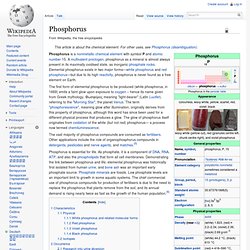
The term "phosphorescence", meaning glow after illumination, originally derives from this property of phosphorus, although this word has since been used for a different physical process that produces a glow. The glow of phosphorus itself originates from oxidation of the white (but not red) phosphorus— a process now termed chemiluminescence. The vast majority of phosphorus compounds are consumed as fertilisers.
Potassium. Most industrial chemical applications of potassium employ the relatively high solubility in water of potassium compounds, such as potassium soaps.
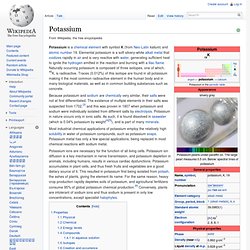
Potassium metal has only a few special applications, being replaced in most chemical reactions with sodium metal. Potassium ions are necessary for the function of all living cells. Sodium. Sodium is a chemical element with the symbol Na (from Latin: natrium) and atomic number 11.

It is a soft, silver-white, highly reactive metal and is a member of the alkali metals; its only stable isotope is 23Na. The free metal does not occur in nature, but instead must be prepared from its compounds; it was first isolated by Humphry Davy in 1807 by the electrolysis of sodium hydroxide. Sodium is the sixth most abundant element in the Earth's crust, and exists in numerous minerals such as feldspars, sodalite and rock salt (NaCl). Many salts of sodium are highly water-soluble, and their sodium has been leached by the action of water so that sodium and chlorine (Cl) are the most common dissolved elements by weight in the Earth's bodies of oceanic water. Sulfur. Sulfur occurs naturally as the pure element (native sulfur) and as sulfide and sulfate minerals.

Elemental sulfur crystals are commonly sought after by mineral collectors for their distinct, brightly colored polyhedron shapes. Zinc. Dietary mineral. Dietary elements (commonly known as dietary minerals or mineral nutrients) are the chemical elements required by living organisms, other than the four elements carbon, hydrogen, nitrogen, and oxygen present in common organic molecules.

The term "dietary mineral" is archaic, as it describes chemical elements rather than actual minerals. Calcium. Notable characteristics Flame test.
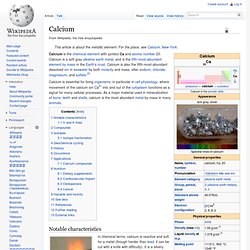
Brick-red color originates from calcium. Calcium, with a density of 1.55 g/cm3, is the lightest of the alkaline earth metals; magnesium (specific gravity 1.74) and beryllium (1.84) are more dense, although lighter in atomic mass. From strontium onward, the alkali earth metals become more dense with increasing atomic mass. It has two allotropes.[5] Iron. Iron chemical compounds, which include ferrous and ferric compounds, have many uses.
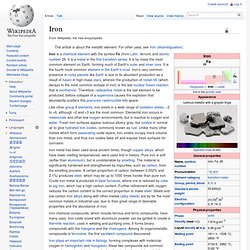
Iron oxide mixed with aluminium powder can be ignited to create a thermite reaction, used in welding and purifying ores. It forms binary compounds with the halogens and the chalcogens. Among its organometallic compounds is ferrocene, the first sandwich compound discovered. Iron plays an important role in biology, forming complexes with molecular oxygen in hemoglobin and myoglobin; these two compounds are common oxygen transport proteins in vertebrates.
Iron is also the metal used at the active site of many important redox enzymes dealing with cellular respiration and oxidation and reduction in plants and animals. Characteristics Mechanical properties The mechanical properties of iron and its alloys can be evaluated using a variety of tests, including the Brinell test, Rockwell test and the Vickers hardness test. Phase diagram and allotropes. Magnesium. In vegetation, magnesium is the metallic ion at the center of chlorophyll, and is, thus, a common additive to fertilizers.[6] Characteristics[edit] Physical properties[edit] Elemental magnesium is a rather strong, silvery-white, light-weight metal (two-thirds the density of aluminium).
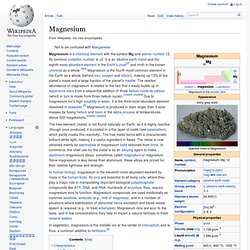
It tarnishes slightly when exposed to air, although, unlike the alkali metals, an oxygen-free environment is unnecessary for storage because magnesium is protected by a thin layer of oxide that is fairly impermeable and difficult to remove. Like its lower periodic table group neighbor calcium, magnesium reacts with water at room temperature, though it reacts much more slowly than calcium.